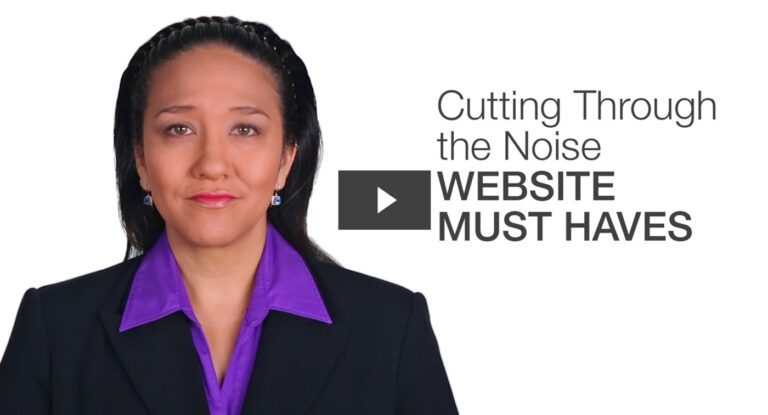Your website is an exceptional place to match your brand messaging to the needs of your different buyer personas and website visitors. As a result, you will have a better-performing, longer-standing, and more productive community building machine. Let’s take a look at the “must have” technical elements of a successful website.
A modern website redesign can be a daunting task for any business. Trying to balance search engine standards and the wishes of your current or potential website visitors can be a juggling act.
Rankings are essential to any successful website, and in fact, to any content published to the web. Understanding where your website ranks prior to changing anything is just as important.
Before we jump into the elements you should include in your next website redesign, you should understand how Google indexes website and searches online:
In Google’s own words, their mission is to “organize the world’s information and make it universally accessible and useful.” Although this is a fairly straightforward mission, the process by which this is executed is a bit more complicated, and can affect your site—and its search ranking—positively or negatively.
What process does Google use to analyze and evaluate to determine a website’s rank?
Google uses crawling and indexing to search and evaluate pages and add them to its database.
Website evaluation and ranking is based on information gathered by Googlebot (also known as a robot, bot, or spider). This ‘bot’ uses an algorithm that aims to index the Internet and better the needs of the searcher. This algorithm is ever-changing and evolves along with the Internet. This process is referred to as ‘crawling.’ Information is gathered during the crawling process, but it is organized by indexing. When a site is crawled, it is fetched by the engine and reviewed, but when it is indexed, the information is saved and able to appear in search engine results.
When Google visits your site, it takes a lot of information into account. The first of these factors are connectivity and load time. If your site is down or loads incredibly slowly, bots won’t return as frequently, and your Google ranking will fall (you will appear less often in search results).
How often does Google crawl websites?
There’s not one cut-and-dried answer to this question. The frequency with which Google crawls sites varies widely, depending on various factors. These factors are mainly connectivity/load time, frequency of updates, site maps, and inbound links. For example: News sites that are constantly adding and updating content are crawled multiple times per minute. On the other hand, websites that are updated much less frequently will be crawled less, perhaps only a few times a week.
To find out how often your site is crawled, you can log into your Google webmaster tools and view your ‘crawl stats’ to get an idea of how often Google is indexing your site.
When does Google crawl websites?
Google is a hard-working engine, maybe the hardest. Google and its bots are working around the clock crawling and updating search results. As mentioned before, site rankings can be updated frequently if your website is up to the Google standard.
How does Google index results?
If a page is crawled and deemed worthy to be included in the search engine database, Google saves information about the page, including all the text on the page, title tags, ALT tags, and more.
How does Google serve search engine results?
When someone enters a search into Google, their servers access the massive database they have compiled from all the crawling and indexing, and attempts to provide the searcher with the most relevant results. There are several factors that will cue Google to display your site in these results. Your site will be more likely to appear in search results if:
- Google is able to easily crawl and index your site.
- You have more high-quality inbound links (other sites linking to your pages).
- A searcher enters a keyword for which Google’s algorithm has ranked your site highly.
Why does Google put so much effort into search ranking?
Google services over 70% of desktop searches and over 90% of mobile searches worldwide. In light of their mission statement, and their dominance in the search field, it is no surprise that Google puts so much effort into the search ranking process. Searchers place a huge amount of trust in Google to yield relevant results from the most authoritative sources. To stay at the top of the game with effective search ranking, you have to put in a lot of legwork. Understanding Google is a process that will take time and effort.
Unfortunately, if your site is not performing at its best, you are probably missing out on valuable site visits.
There are several major elements you must include within your redesign to achieve maximum return on investment for your project.
- Make your site responsive.
- Make sure your site is accessible and legible to your visitors, no matter how they come to your site. Being ill-prepared for mobile site visitors could result in loss of potential customers.
- Plan your site so it makes sense on a multitude of devices among desktop, tablet and phone configurations.
- Develop “smart content.”
- Use smart content, also referred to as dynamic content. Smart content changes based on the interests or past behavior of the viewer. (HubSpot)
- Provide user-friendly navigation.
- Navigation needs to provide clear labels that direct visitors to pages, let them know what page they are on, and how to return to the homepage.
- To make your site easy-to-navigate, you should also be sure it has a search function.
- Write effective copy.
- Immediately draw the reader in with exciting benefits and enticing copy so you can lead them toward the sale.
- Establish your credibility—nobody will buy from you if they don’t feel they can trust you.
- Describe the benefits of your product or service and explain why your visitors need it.
- Develop sound strategy.
- Be sure to have your plan completely mapped out before beginning your redesign.
- Establish SEO tactics.
- Research keywords for your industry and target market, and integrate them into your website content, including site copy, page titles, meta descriptions, header tags, and URLs.
- Internal links improve SEO, so include them when appropriate.
- Provide a clear “call to action.”
- Use concise and directive language to guide users to take action on your site.
- Select well-chosen images.
- Make sure your choice of image(s) add value to your content. They should be optimized for fast loading and have a proper naming convention.
- Develop a strong “opt-in” offer.
- Having a form available for your website visitors to fill out in return for valuable content is a great way to bridge the communication gap within your website and content community.

Once you have completed the website redesign process, your site should be ready to rank well on any Google search.
However, make sure you have the content needed to support the search queries from potential website visitors. If you don’t, your bounce rate will increase, and all of the time invested in your website redesign may get lost in the content saturation of the Internet.
If you are developing a website to increase visibility and brand awareness, or are launching a new product or service, it is imperative to include the necessary elements of a modern website. A website visitor should embark on a journey through your website while they familiarize themselves with your product, service or content offering. Build community with your website and effectively and efficiently establish awareness and show off all you have to offer.
Maybe, your company is not at a place to implement a complete website overhaul to include the elements above. That’s okay.
But what if you could make a few updates and have this hard-working machine up and running 24 hours a day—always attracting leads, converting visitors into contacts, and growing your base of customers and brand evangelists?
Sounds good, right?
Let’s take a look at some action items you can take care of today to better position your website for success.
First…
- Establish a Unique Value Proposition: Before you begin crafting your content, be clear about your Unique Value Proposition (UVP) so that it is consistent across your entire website. If you attract a high number of unique visitors, or you’re a new business, your visitors might not be very familiar with you and what you do.
- Set goals: Every website has a purpose. Sometimes that purpose is lost in the design planning stage if you are not careful. Establishing clearly defined goals in the planning phase will assist in building the concrete foundation your website desperately needs to achieve success. Think about it. Each piece of content you create has an objective. Your contact page is designed to provide information to the visitor, and the information living on the contact page should reflect means of contact for your company. Imagine you have a contact page with images of your office building or storefront without a telephone number—defeats the purpose, right? This example is a very basic one, but the principle applies to each and every page of your website. Set goals and achieve them with a well-thought-out website development plan.
- Organize your page titles, header tags, and on-page SEO tactics: If your website has clever, but arbitrary titles that do not clearly describe its purpose to visitors, it is ineffective to both the visitors and search engines. You should have a distinguished list of keywords that will clearly communicate the objectives of your website, and this keyword should align with your business goals.
Example
Startup Sally has decided it is time to get the website development process in motion for her newly developed SaaS program for hair stylists to aid with time management and business organization. The keyword list she has chosen is about 200 keywords long and all focus on three main themes:
- Time management in a salon setting
- Creative customer service for salon stylists
- Salon and stylist business building strategies
These themes are all focused on the potential customer and their particular needs as it pertains to Sally’s product. Sally’s keyword list could include keywords such as:
- managing time in a salon setting
- salon customer service
- hair stylist time management
- business building skills in a salon setting
- and so on…
The idea here is to pick the keywords that best align with what your target audience is searching for, and use these keywords in the page titles and copy on your website.
This helps your website visitors not only navigate your website but understand exactly why their search engine brought them to your site in the first place.
For every page, pick one or two keywords that the content of the page revolves around. Once you determine the keyword(s), use on-page SEO tactics, such as internal link building and optimizing your header tags (H1, H2, H3, etc.) to encourage search engine rankings but still appeal to the user experience.
Establish a need-based website development plan.
If your business is fast paced, you may have found yourself thinking about your website needs from time to time, but something ‘bigger’ always comes up. When it’s time to sit down and have a meeting of the web development minds, it may be difficult to remember all of the smaller details. Create a need-based website development plan and keep it as a living document. Split this document in a way that presents prioritized needs of your website from all aspects of the business. Also, include a spot for internal and external website update suggestions. This will ensure your website evolves in the most productive manner possible if you are performing an in-house website redesign. If you are currently working with a design service or are looking into one, this document will make the process much more fluid.
As you can see there are several ways you can adjust and tweak your website to better serve your visitors. When you are establishing brand recognition in a manner that boasts user experience excellence, your website must provide that excellence as well. Employ these tips in your next website redesign and see how your traffic and qualified lead generation improves.
Subscribe to our BLOG
Stay in touch & learn how to attract customers, become a thought leader, create effective marketing campaigns, & more.





